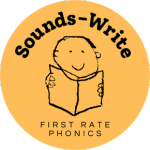When we talk about phonics, two core concepts we discuss are phonemes and graphemes. It’s easy to switch off if you don’t understand these two cornerstones of literacy, or to get overloaded with all the new terms when you’re hearing them for the first time. So today, let’s get to grips with what they are, and the difference between them!
Phonemes or sounds
Each sound you hear in a word is a phoneme. It’s the smallest unit of sound that makes up a whole word. For instance, if you say the word ‘dog’ out loud, you will hear that it is made up of three phonemes: /d/ /o/ /g/
The English language has around 44 phonemes (depending on your accent), comprising 24 consonant sounds and 20 vowel sounds.
A phoneme can can be represented by more than one letter. For example:
- dog has 3 phonemes: /d/ /o/ /g/. Each phoneme is represented by 1 letter.
- ship also has 3 phonemes /sh/ /i/ /p/. But the word has 4 letters. < sh > is 2 letters, but it’s one sound.
- light also has 3 phonemes /l/ /ie/ /t/. But the word has 5 letters. < igh > is 3 letters, but it’s one sound /ie/.
- weight also has 3 phonemes /w/ /ae/ /t/. But the word has 6 letters. < eigh > is 4 letters, but it’s one sound /ae/.
Graphemes or spellings
A grapheme is the symbol used to represent a single phoneme. To put it more simply, a grapheme is a spelling. It’s a letter or group of letters representing 1 sound. For example:
- team contains the 2-letter grapheme < ea >, which represents the sound /ee/.
- eight contains the 4-letter grapheme < eigh >, which represents the sound /ae/.
It can get a little confusing…
Some phonemes can be spelled with different graphemes The sound /k/ can be spelled with the < c >, < k >, or < ck > graphemes. It can even be spelled < ch > in words like chemistry!
Many graphemes can represent more than one sound. In words such as odd, no, son and to, the grapheme < o > represents 4 different phonemes: /o/, /oe/, /u/, /oo/.
A trick to help you out!
As we said, it can be hard
- phoneme comes from the Greek word phōnēma, which means sound. Other words that come from the same origin include telephone, symphony and saxophone. Notice that they all have something to do with sound.
- grapheme comes from the Greek word gráphō, which means to draw. Other words that come from the same origin include graphic, paragraph and (most obviously) graph. Notice that they all have something to do with visual representations or writing.
Sounds-Write Webinars
Learn more about the Sounds-Write approach, our literacy training and decodable books by signing up to a free webinar.

